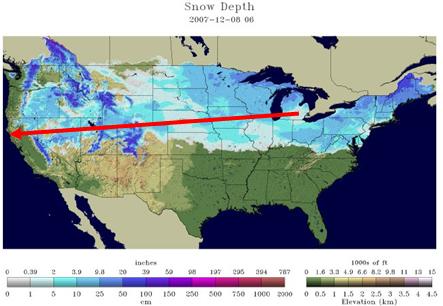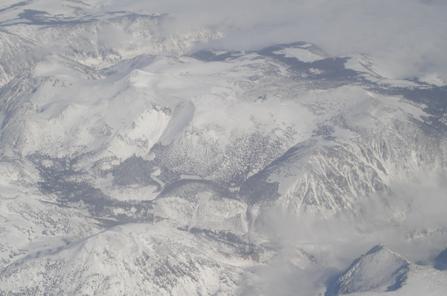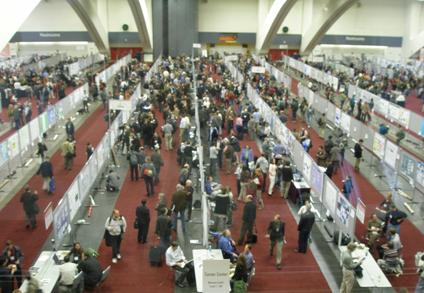11 December 2007
Today I am in San Francisco, California at the Annual American Geophysical Union (AGU) conference. I heard today that there are over 15,000 scientists here. I bet you did not know that scientists are always learning. As you can see in Figure 1, the areas that I flew over were snow covered for the most part, that is if there were no clouds which was very common.

Figure 1. My flight path over the United States from Detroit, Michigan to San Francisco, California.
I took a bunch of pictures as I was flying from Detroit, Michigan to San Francisco, California.

Figure 2. Picture I took from my airplane of a snow covered mountainous area.
The view was great. Isn’t it amazing the quality of pictures that can be taken from an airplane with a regular digital camera? I really enjoy having a window seat when I fly.
A conference like this one is a way for scientists to share information. There are two ways that we present our work to other scientists. One is through an oral presentation, i.e. giving a talk. This is similar to what your teacher might do presenting information to you in class. The other way is through poster presentations. See figure 3 below. In this picture, there are hundreds of posters being presented at the same time. Poster presentations are very similar to science fair projects that students do.

Figure 3. Poster session at the AGU meeting December 11, 2007.
Attending the AGU meeting is also a chance for me to see my scientist friends again.
I learned some interesting things about remote sensing of snow today. Scientists at NASA Marshall Space Flight Center are using a satellite sensor called AMSR-E (Advanced Microwave Scanning Radiometer EOS). It is a sensor that uses microwave wavelengths to estimate the amount of water, called snow water equivalent, in the snow at specific locations. Interestingly, one scientist said that the ability to accurately retrieve snow water equivalent from AMSR-E is dependent on the surface temperature. This may be a type of project that could use student observations from the surface temperature field campaign.
Thirty schools and counting have participated thus far in the surface temperature field campaign. Thank you for all of your hard work.
| Roswell Kent Middle School, Akron, Ohio, USA Rockhill Elementary School, Alliance, Ohio, USA Dalton High School, Dalton, Ohio, USA Chartiers-Houston Jr./Sr. High School, Houston, Pennsylvania, USA Cloverleaf High School, Lodi, Ohio, USA The Morton Arboretum Youth Education Dept., Lisle, Illinois, USA Mill Creek Middle School, Comstock Park, Michigan, USA Kilingi-Nomme Gymnasium, Parnumaa, Estonia National Presbyterian School, Washington, DC, USA Polaris Career Center, Middleburg Heights, Ohio, USA White Cloud Public, White Cloud, Michigan, USA Steeple Run School, Naperville, Illinois, USA Blue Valley High School, Stilwell, Kansas, USA Kittrell Elementary School, Waterloo, Iowa, USA Lorain Community College Early College High School, Elyria, Ohio, USA Ingomar Middle School, Pittsburgh, Pennsylvania, USA Moosewood Farm Home School, Fairbanks, Alaska, USA Roxboro Middle School, Cleveland Heights, Ohio, USA Bowling Green State University, Bowling Green, Ohio, USA Ida Elementary School, Ida, Michigan, USA Whitehall High School, Whitehall, Michigan, USA Taaksi Basic School, EE2914, Viljandimaa, Estonia Birchwood School, Cleveland, Ohio, USA Gimnazium in Toszek, Toszek, Poland Waynesboro Senior High School, Waynesboro, Pennsylvania, USA Eastwood Middle School, Pemberville, Ohio, USA Orange Elementary School, Waterloo, Iowa, USA Estes Park High School, Estes Park, Colorado, USA Hudsonville High School, Hudsonville, Michigan, USA Main Street School, Norwalk, Ohio, USA |
Take care,
Dr. C
